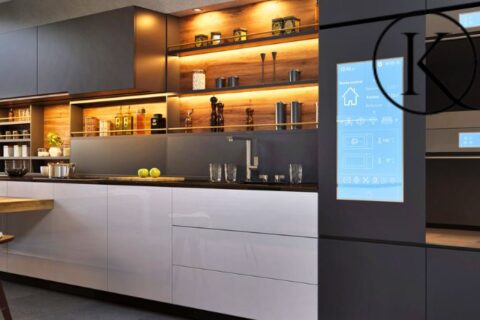Decluttering kitchen gadgets simplifies cooking and reduces mess. Keep only multi-purpose tools to optimize space and efficiency.
Decluttering your kitchen can feel as refreshing as it is challenging, but taking a smart approach to your collection of gadgets is key. Every home cook knows the allure of the latest kitchen gadgets that promise to slice, dice, and simplify the cooking process.
Yet, as time goes by, drawers and cabinets often become crammed with rarely used items, making it difficult to find what you need. By focusing on versatile and frequently used gadgets, you pave the way for a more organized and functional kitchen environment. Embracing minimalism in your culinary space not only clears the physical clutter but also reduces decision fatigue, streamlines meal preparation, and creates a more inviting space for you to enjoy your cooking adventures. Effective decluttering hinges on assessing the usefulness and frequency of each gadget, leading to a more manageable and pleasurable kitchen experience.
Assessing The Need For Decluttering
The kitchen, known as the heart of the home, often becomes a repository for gadgets and gizmos that promise to make food prep easier and more efficient. But when is the last time you used that avocado slicer or melon baller? Assessing the need for decluttering is an essential first step in creating a more functional and streamlined kitchen environment. It’s time to evaluate what’s necessary and what’s simply taking up valuable space.
Evaluating Current Gadget Usage
Start by taking inventory of what’s in your kitchen drawers and cabinets. Pull out every gadget and ask yourself some hard questions. How often do you use that zucchini spiralizer or that electric can opener? If it’s been collecting dust for more than six months, it’s likely not as essential as you once thought. Create two lists – one for often-used items and another for those rarely reached for. This will give you a clear picture of which gadgets justify their space in your kitchen.
- Sort gadgets based on frequency of use
- Be realistic about what you actually need
- Consider the versatility of each item
Identifying Excess And Redundant Items
As kitchens accumulate tools over time, it’s common to find multiples of the same type of gadget. Do you have three different brands of peelers or a handful of measuring spoon sets? This is the perfect time to ask yourself which ones you prefer and why. Keep the best and donate the rest. By identifying redundancies, you remove the clutter that complicates meal preparation.
| Gadget Type | Quantity Owned | Decision |
|---|---|---|
| Peelers | 3 | Keep 1, Donate 2 |
| Measuring Spoons | 4 | Keep 1 set, Donate 3 |
| Graters | 2 | Keep 1, Donate 1 |
Organizing And Sorting Process
Welcome to the ultimate guide to Decluttering Kitchen Gadgets. A clutter-free kitchen is not only pleasing to the eye but also functional and efficient. Let’s explore the organizing and sorting process that will transform your chaotic kitchen into a model of order. With the right strategy, every whisk, peeler, and spatula will find its rightful home!
Categorizing Gadgets Based On Frequency Of Use
The first, and perhaps most crucial step in decluttering kitchen gadgets is to categorize them by how often you use them. A smart categorization will streamline your kitchen activities, saving you time and frustration. Let’s break it down:
- Daily Use: Items you reach for on a daily basis should be the most accessible. This group includes your favorite knives, cutting boards, and mixing spoons.
- Weekly Use: Gadgets like salad spinners, graters, and measuring cups might not be essential every day but are still used regularly. These can be stored within arm’s reach.
- Occasional Use: Specialty tools like cherry pitters, pastry brushes, or food processors tend to have a very specific purpose and should be stored out of the way but still within reach when needed.
- Rarely Used: Think turkey baster, canning equipment, or fondue pots. If an item falls into this group, consider if it’s necessary to keep or if it can be donated.
Designating Storage Areas For Each Category
With categories defined, it’s time to assign a storage area for each, ensuring efficiency in your kitchen’s layout. Here’s how to allocate space effectively:
- High-Traffic Zones: Reserve the prime real estate areas in your kitchen, like the space right around your stove or main work counter, for daily-use items.
- Secondary Storage: Use the lower cabinets or shelves that are still within reach for weekly-use gadgets, preferably sorted in labeled bins or drawers.
- Tertiary Spots: Higher shelves or the back of cabinets can house occasionally used gadgets. Use clear containers to keep them visible but neatly stored away.
- Off-Site Storage: For rarely used items, consider a closet or storage area outside the kitchen. This makes room for more commonly used items and keeps your workspace clear.
Remember, the goal is to maximize convenience and minimize clutter. Each gadget should have a home that reflects how often you use it, making your kitchen a functional, organized space you love cooking in.
Smart Storage Solutions
Welcome to our guide on decluttering your kitchen gadgets. The key to maintaining an orderly kitchen lies in Smart Storage Solutions. By optimizing space with clever storage strategies, you can turn a cluttered kitchen into a model of efficiency. Below, we delve into practical ways to enhance your kitchen’s functionality.
Utilizing Vertical And Wall Storage Options
Maximizing vertical space is a game changer for kitchens. Wall storage solutions free up counter space and keep gadgets within easy reach. Consider these ideas:
- Install floating shelves for frequently used items like spice jars and coffee mugs.
- Use a pegboard wall organizer to customize storage for pots, pans, and utensils.
- Hang a magnetic knife strip to safely store and display your knives.
- Mount racks inside cabinet doors for lid storage, cutting boards, or baking sheets.
These vertical storage options not only create a tidy kitchen but also infuse a touch of modern style.
Implementing Drawer And Cabinet Organizers
Drawers and cabinets are prime real estate in the kitchen. With proper organizers, you can keep everything in order. Try these tips:
| Gadget Category | Organizer Type | Benefits |
|---|---|---|
| Cooking Utensils | Tray Dividers | Prevent clutter and make utensils quickly accessible. |
| Small Appliances | Pull-out Shelves | Easy access and efficient use of deep cabinet spaces. |
| Spices and Condiments | Lazy Susans | Offer visibility and reachability for small containers. |
By designating a place for every gadget, you transform your cabinets and drawers into neatly arranged spaces. This step reduces the time spent searching for items and increases your productivity in the kitchen.
Mindful Consumption
When it comes to maintaining a clutter-free kitchen, the act of mindful consumption is pivotal. It’s not just about organizing what’s already there; it’s about being intentional with what enters your space in the first place. By cultivating an awareness of our consumption habits, we invite a sense of calm and efficiency into our kitchens. Gone are the days of sifting through drawers crowded with single-use gadgets; welcome a new era of clarity and simplicity in your cooking sanctuary.
Evaluating Future Gadget Purchases
Before welcoming a new gadget into your kitchen, pause and ask some critical questions. Is this tool a necessity or a novelty? Let’s slash the impulse buys and consider the following points:
- Functionality: Will this gadget serve a unique, irreplaceable function, or does something you already own do the job?
- Frequency of Use: Could this be an item you’ll use regularly, or will it collect dust after a single use?
- Storage Space: Do you have a specific place for this gadget, or will it contribute to the clutter?
- Quality over Quantity: Aim for buying fewer, better-quality items that will endure the test of time.
- Environmental Impact: Consider the gadget’s lifecycle – from production to disposal. Choose sustainable options whenever possible.
Remember: A mindful evaluation can prevent unnecessary gadget accumulation and create a purposeful kitchen environment.
Adopting A Minimalist Approach To Kitchen Tools
Adopting a minimalist approach to your kitchen’s arsenal allows you to focus on quality and versatility. The goal is to curate a set of tools that can perform multiple functions, cutting down on the need for excessive gadgets. A minimalist kitchen is not sparse; it’s strategically stocked. Below are strategies to achieve this:
- Assess Your Current Tools – Discard duplicates and gadgets that serve only one purpose, which another tool can also accomplish.
- Prioritize Multi-Taskers – Champion tools like cast iron skillets that can go from stovetop to oven, or high-quality knives that can handle a variety of cutting tasks.
- Set Limits – Define clear boundaries. For instance, decide that you’ll only have three different sizes of saucepans or a single set of measuring spoons.
- Replace Wisely – When a tool wears out, replace it with one that’s even more versatile or with something that you’ve identified as missing from your core set.
Transitioning to a minimalist kitchen setup not only reduces clutter but also saves time spent on cleaning and organization, and enhances your cooking experience by ensuring everything has its place and purpose.
Maintenance And Upkeep
Proper maintenance and upkeep of kitchen gadgets not only prolongs their lifespan but also ensures they remain safe and efficient in food preparation. With the rise of minimalist kitchens and the trend towards owning fewer, higher-quality items, taking care of what we have becomes even more crucial. The following sections delineate the necessities of regular cleaning regimens and the importance of periodic reassessment of kitchen organization.
Establishing Regular Cleaning And Maintenance Routines
Consistency is key when it comes to keeping kitchen gadgets functioning at their best. Regular cleaning prevents the buildup of food particles and bacteria, while consistent maintenance checks help catch any wear and tear before it leads to bigger problems. Here’s a simple guide to establish a preventative care schedule for your kitchen equipment:
- Daily: Wipe down gadgets with multi-purpose kitchen cleaner or a solution of vinegar and water.
- Weekly: Perform a deeper clean on frequently used items and check for any parts that may need repair.
- Monthly: Do a full inventory to ensure everything is working correctly; replace any worn-out parts if necessary.
- Seasonally: Deep clean all equipment, including those seldom used, and apply any necessary lubrication to moving parts.
Revisiting Organization Periodically For Adjustments
The way we use our kitchens evolves over time, and so should the organization of our tools and gadgets. Regular reassessment of your kitchen’s layout and gadget storage can help maintain an efficient and enjoyable cooking environment. Follow these guidelines to stay on top of organizational adjustments:
- Take note of gadgets that haven’t been used in a while and consider if they truly need to remain within reach.
- Investigate new organizational tools or solutions that could better accommodate your current kitchen activities.
- Reposition frequently used items to more accessible places and move rarely used gadgets to storage.
- Donate or sell gadgets that no longer serve a purpose in your culinary routine.
Frequently Asked Questions Of Decluttering Kitchen Gadgets
What Is The 20 20 20 Rule For Decluttering?
The 20/20/20 rule for decluttering suggests if you hesitate to discard an item, consider if it’s worth $20 or less and can be replaced within 20 minutes of your home. If so, you can let it go. This rule helps simplify decluttering decisions.
How Do You Declutter Kitchen Appliances?
Sort and prioritize appliances by frequency of use. Donate or sell rarely used items. Organize cords and designate storage areas for each appliance. Regularly evaluate and streamline your collection to maintain a clutter-free kitchen.
What Can I Do With Old Kitchen Gadgets?
Repurpose old kitchen gadgets as planters, donate them, sell at garage sales, or recycle them properly. Crafting projects can also give them new life.
How Do I Get Rid Of Things In My Kitchen?
Declutter your kitchen by sorting items into three categories: keep, donate, and throw away. Recycle and responsibly dispose of unwanted items. Contact local charities for donation options, and utilize garage sales or online marketplaces for valuable items. Regularly reassess for optimal space management.
Conclusion
Streamlining your kitchen with just the essentials not only saves space, but also simplifies meal prep. Remember, every gadget should earn its keep! Embrace a minimalist kitchen approach and enjoy the benefits of a clutter-free space. Start decluttering today, and create a kitchen that inspires culinary creativity and calmness with every use.



